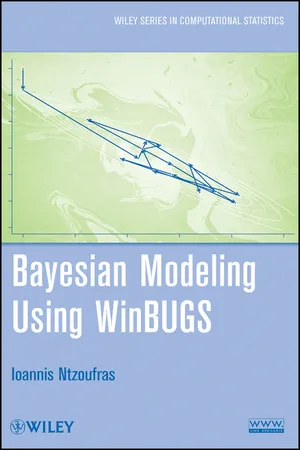
- English
- ePUB (mobile friendly)
- Available on iOS & Android
Bayesian Modeling Using WinBUGS
About This Book
A hands-on introduction to the principles of Bayesian modeling using WinBUGS
Bayesian Modeling Using WinBUGS provides an easily accessible introduction to the use of WinBUGS programming techniques in a variety of Bayesian modeling settings. The author provides an accessible treatment of the topic, offering readers a smooth introduction to the principles of Bayesian modeling with detailed guidance on the practical implementation of key principles.
The book begins with a basic introduction to Bayesian inference and the WinBUGS software and goes on to cover key topics, including:
-
Markov Chain Monte Carlo algorithms in Bayesian inference
-
Generalized linear models
-
Bayesian hierarchical models
-
Predictive distribution and model checking
-
Bayesian model and variable evaluation
Computational notes and screen captures illustrate the use of both WinBUGS as well as R software to apply the discussed techniques. Exercises at the end of each chapter allow readers to test their understanding of the presented concepts and all data sets and code are available on the book's related Web site.
Requiring only a working knowledge of probability theory and statistics, Bayesian Modeling Using WinBUGS serves as an excellent book for courses on Bayesian statistics at the upper-undergraduate and graduate levels. It is also a valuable reference for researchers and practitioners in the fields of statistics, actuarial science, medicine, and the social sciences who use WinBUGS in their everyday work.
Frequently asked questions
Information
Table of contents
- COVER
- TITLE
- COPYRIGHT
- PREFACE
- ACKNOWLEDGMENTS
- ACRONYMS
- CHAPTER 1: INTRODUCTION TO BAYESIAN INFERENCE
- CHAPTER 2: MARKOV CHAIN MONTE CARLO ALGORITHMS IN BAYESIAN INFERENCE
- CHAPTER 3: WinBUGS SOFTWARE: INTRODUCTION, SETUP, AND BASIC ANALYSIS
- CHAPTER 4: WinBUGS SOFTWARE: ILLUSTRATION, RESULTS, AND FURTHER ANALYSIS
- CHAPTER 5: INTRODUCTION TO BAYESIAN MODELS: NORMAL MODELS
- CHAPTER 6: INCORPORATING CATEGORICAL VARIABLES IN NORMAL MODELS AND FURTHER MODELING ISSUES
- CHAPTER 7: INTRODUCTION TO GENERALIZED LINEAR MODELS: BINOMIAL AND POISSON DATA
- CHAPTER 8: MODELS FOR POSITIVE CONTINUOUS DATA, COUNT DATA, AND OTHER GLM-BASED EXTENSIONS
- CHAPTER 9: BAYESIAN HIERARCHICAL MODELS
- CHAPTER 10: THE PREDICTIVE DISTRIBUTION AND MODEL CHECKING
- CHAPTER 11: BAYESIAN MODEL AND VARIABLE EVALUATION
- APPENDIX A: MODEL SPECIFICATION VIA DIRECTED ACYCLIC GRAPHS: THE DOODLE MENU
- APPENDIX B: THE BATCH MODE: RUNNING A MODEL IN THE BACKGROUND USING SCRIPTS
- APPENDIX C: CHECKING CONVERGENCE USING CODA/BOA
- APPENDIX D: NOTATION SUMMARY
- REFERENCES
- INDEX